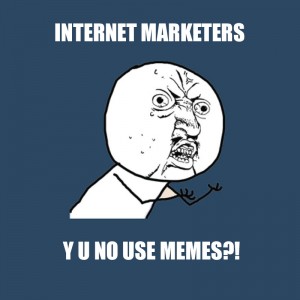“Y U No Guy”, “Lolcats” and the ubiquitous “Ridiculously Photogenic Guy” are all Internet memes that found their way through almost every nook and cranny on the web. Memes become part of the social fabric and are often adopted, morphed and used for advertising campaigns, social media and events. Meme marketing and social media marketing are fast growing segments of advertising and, when used effectively, serve as strong tools for a branding or media strategy. Albeit the pros of meme marketing, there are also cons so we need fully understood what we’re dealing with before launching any meme-based media advertising campaign.
What Are Memes?
Memes are popular ideas and thoughts that get spread out and shared with others. Prior to the Internet, memes could consist of advertising slogans, colloquialisms such as “cool” or “chill”, and were basically anything that society found worthy of sharing with other people. Since the Internet came along, memes were popularized to a whole new level, giving rise to millions of advertising opportunities each day.
What Is “Memejacking”?
When a company, group or individual uses a social meme for marketing their own brand, this leveraging aspect is known as “memejacking”, similar to newsjacking whereby companies leverage on the latest news to promote their products.
One recent example was of this Pizza Shop (I’m not sure where, exactly) which took a meme to promote its one-dollar pizza as seen below.

The origins for this meme is from the comedy cartoon series Futurama, where a character known as “Fry” shows us his doubtful look.
Typically, this meme is coupled with the captions, “Not sure if … Or Just ….” to show the disbelief that something was too good to be true and you’re just as confused as our poor friend, Fry.
The other meme that you see beside Fry is known as “Philosoraptor”, and I’m pretty sure you realize that these memes are quite aptly named. Philosoraptor is basically a velociraptor that dwells itself in Philosophy, hence the name and how it is used by the Pizza Shop.
The whole memejacking concept basically involves using an existing meme with alterations to spread a brand or idea, just like the Pizza Shop. You can definitely do the same. But if you’re still unfamiliar with what’s trending these days, there’s always Google or if you merely brush up your knowledge on some memes, you can go to knowyourmemes.com.
Meme Leveraging Pros
Leveraging, “Piggybacking”, call it what you want but it is definitely something that works for marketers in any given generation. Even traditionally, we had that plain white T-shirt basically meant, “I love New York” even though a heart image represented “love” and N.Y. represented “New York”. Nonetheless, this T-shirt became exposed worldwide for the fact that it was a simple yet decent-looking souvenir for tourists that visited the Big Apple. We can see these I *heart* T-shirts everywhere, depending on the place that you’re in.

Pro #1: Exposure
So if there are people that haven’t heard about you or your brand before, be one of the few companies that are always up to current trends and use memes in your marketing. This is good publicity we’re talking here. When a meme catches on it is very likely that when seen, even as part of an advertisement, it will catch the eyes of the audience that brought it to popularity in the first place. This means a new audience or group of consumers is exposed to the product/event. It is always a positive thing to have the product or brand exposed to as many different groups and demographics as possible. Open up the world with memes.
Pro #2: Familiarity/ Empathy
Memes bring advertising to a very personal and home-based system. When the general public starts to include the meme in daily references with conversation, emails or social media communications, the meme and advertising becomes less in-your-face and much more like a sitcom or television show with characters that are seem like your friends. There is no substitute for this and it is one of the biggest pro aspects of memejacking and meme leveraging in advertising and branding.
Pro #3: Trend-setting
As mentioned before, not many companies do meme marketing. There’s a good reason for it though – they’re old. Alright, that’s probably a little bit offensive. What I mean is that these companies simply aren’t keeping up with times and it is probably because they don’t need to or they just don’t know how to. With more and more Gen Ys/Millenials now heading Fortune 500 companies there is now a paradigm shift in our target audiences and the way we conduct digital marketing. Meme marketing lets us tap into the collective social psyche of the time. Memes grow due to exposure, “coolness factor,” and the ability of the meme to be easily altered or included in pop culture references. As long as we’re able use memes effectively in our marketing campaigns, we’ll be known as “cool”, at least for a while.
Meme Leveraging Cons
There’s always a good side and a bad side to anything, even for memes. Hopefully, this article serves as a guide as to whether memes could be effectively used in your social media marketing campaign.
Con #1: Legal rights
If a memejacking is done without fully vetting the legal process or rights of the meme, it can open up a world of hurt for the memejacker. Even though it’s not common, lawsuits for damages are a very real possibility. This is why it is so important to research the rights to all social memes before leveraging them into advertising or branding strategies. One bad move here could derail the entire ad campaign and cost the company or group more than they can afford. The hint here is always doing your homework.
Con #2: Fads tend to fade over time
Another huge con in leveraging memes is a sort of “expiration date” issue. Memes come and go, and when they go they tend to becomes stale, uncool, or even taboo to reference. If the company or brand invests all its time and money into a meme that is on the fast track to extinction, the entire strategy is lost. It is important to understand the lifespan of memes and suss out the relevance of any social meme being considered for leveraging and memejacking. Have a staff that is fully knowledgeable about social media trends and pop culture. This pays off in the end.
Con #3: Unwanted negativity
It is also possible that the meme will alienate or cause groups to ostracize the brand. Memes that are highly controversial should be avoided if the branding goal is to reach as many people as possible with the least amount of controversy. Something as benign as a cherub in a cradle can be seen as controversial to some groups. Always figure out who will like or dislike the meme being used for the leverage program and campaign. Some might find the meme below funny, but to others it might prove too offensive.

Conclusion
It never hurts to go to the “tree” to pick fresh fruit, so to speak. The Internet tends to be a younger persons’ game, but it doesn’t mean you can’t play it. Go to local university campuses or colleges and sit and observe what is currently trendy and hip. Look at their t-shirts, hats and clothing for logos or meme references. Ask what they are watching and reading online to get solid information on the memes of the day – just don’t be creepy going about it.
Because memes are popular with youth, they tend to be fickle and quick. Always be sure you are staying current by constantly engaging yourself on social media platforms.
Be hip, be current and keep the public’s eye turned toward the fun stuff at the moment. That’s all the advice I can offer to make your product or service stand out and shine among the masses.
What do you think of Meme Marketing?








